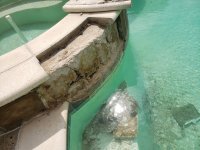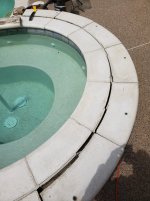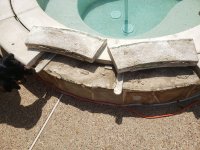I live in Dallas and I suspect the extreme freeze this winter may have led to this.
Is this as simple as finding some magic tool that will remove the cement / grout and cementing it back into place?
Or is this one of those "That is a band aid and there is a much bigger problem, get a professional" type of things?
I am fairly handy and great at figuring things out but I don't know what I don't know.
My instinct was to look up the best tool for removing the cement from the underside of the coping.
I want to actually remove and replace all the grout in the coping because it is cracking badly.
Next step was to buy tiles that closely match the existing ones. Learn what I need to do to affix them to the lower wall.
Then do the same research on the stone pieces
And then the coping.
I have basic tools / power tools.
Also would be worth asking what one would expect to pay someone to repair this for me.
Thanks in advance.

Is this as simple as finding some magic tool that will remove the cement / grout and cementing it back into place?
Or is this one of those "That is a band aid and there is a much bigger problem, get a professional" type of things?
I am fairly handy and great at figuring things out but I don't know what I don't know.
My instinct was to look up the best tool for removing the cement from the underside of the coping.
I want to actually remove and replace all the grout in the coping because it is cracking badly.
Next step was to buy tiles that closely match the existing ones. Learn what I need to do to affix them to the lower wall.
Then do the same research on the stone pieces
And then the coping.
I have basic tools / power tools.
Also would be worth asking what one would expect to pay someone to repair this for me.
Thanks in advance.





